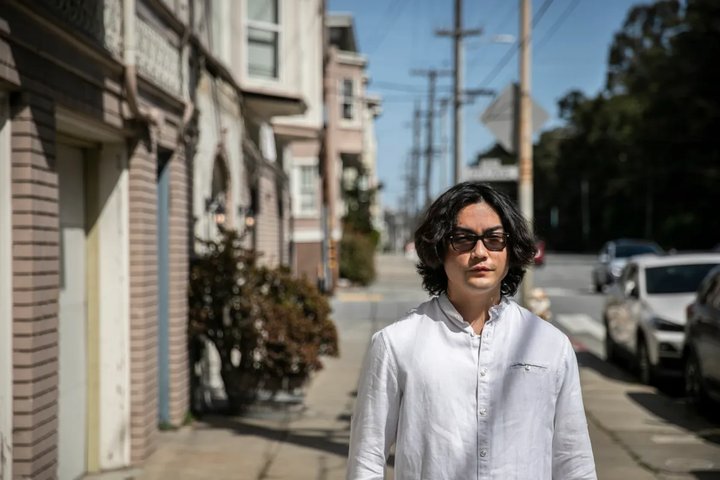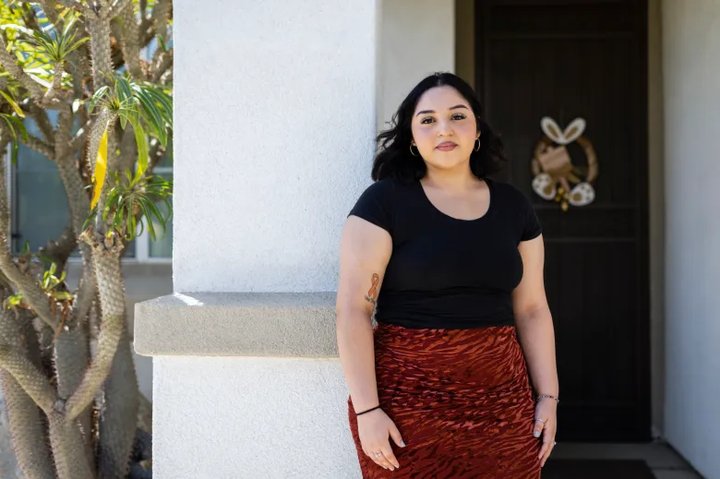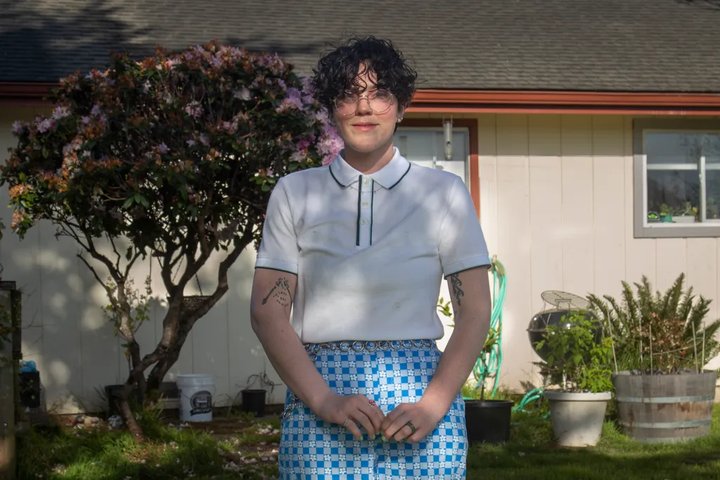Jesse Driskill is photographed outside his home in San Francisco on Apr. 7, 2022. Photo by Martin do Nascimento, CalMatters
California community colleges have seen their enrollment drop by about a fifth during the coronavirus pandemic, with more than 300,000 fewer students enrolled in fall 2021 compared with fall 2019.
“This raises critical concerns about equitable access to higher education as well as the ability to meet workforce needs,” said Paul Feist, vice chancellor of communications for the California Community College Chancellor’s Office. “It is why the entire community college system has mobilized to stabilize and turn back these declines.”
California lawmakers last year gave the system $120 million to help bring students back. So far, as CalMatters has previously reported, progress has been uneven. At 42 of California’s 116 community colleges, more students left in the fall of 2021 than in fall of 2020.
So who exactly is still missing from the state’s community colleges?
Students who need — or decide — to work full time, for one, the chancellor’s office said. That includes parents, who are not only supporting themselves but their families. And it includes people who decided to take advantage of a labor market in which companies, struggling to find enough workers, are paying well above minimum wage for jobs that don’t require a degree.
One out of four prospective students surveyed in December by the Chancellor’s Office said they didn’t enroll because of full-time work. A big factor holding students back was affordability, with 43% of the 400 prospective students surveyed saying that even though the state’s community college tuition is among the lowest in the country, at $46 per unit, it is still too expensive to pursue a degree.
“People think that community college is affordable, and in some ways it is. That total cost of attending college is more than just fees and tuition,” Feist said. “It involves books, housing, child care, and everything that goes into the total cost of success.”
College enrollments are down across the country, although community colleges in California saw steeper declines than in many states.
Some of the enrollment declines can be attributed to demographic trends such as birth rates falling, says Jessica Thompson, vice president of The Institute for College Access and Success, a national organization. But the pandemic, she says, also has exacerbated a lot of pre-existing gaps in who is able to access college and who cannot.
“I’m going to college to fill out paperwork? Are you kidding me?”
— Jesse Driskill, former City College of San Francisco student
People from lower-income families and people of color are at a higher risk of not being able to attend college, or having to drop out, for a number of reasons including caregiving responsibilities, obligations to work, and trouble accessing the technology they need, Thompson says.
Here are the stories of some of the Californians who dropped out from community college over the past two years. They were challenged by online learning, financial needs, and mental health. Many intended, or still intend, to re-enroll, although the decision to leave community college sent all of them down new paths:
Turned off by online learning
Jesse Driskill dropped out of community college before his first course even started. The pandemic stymied the educational plans of many students. For Driskill, it deepened his disillusionment about the entire enterprise.
Attending college was not a certainty for Driskill, 19, who barely made it through high school with passing grades. “I didn’t try at school, and I just didn’t really like school,” he said. “It’s not like I was going to get into a good college. So, my only option was community.”
Driskill waited more than a year after graduating from high school in 2020 to register for classes at City College of San Francisco, at his mother’s encouragement. “You know, she didn’t want a deadbeat son because that kind of sucks,” he joked.
But then he learned that all of his classes would be held online in an asynchronous format. He would only interact with professors and students through Google classroom. “I felt like that was some serious bullshit,” he said. “Like I’m going to college to fill out paperwork? Are you kidding me? I want to talk to people, say hi to people. I want to see faces.”
The lack of in-person interactions made the decision not to attend City College an easy one. He already was unsure about what he wanted to study in college, as most academic subjects seemed obscure and unrelated to his real-life concerns, like making money.
But then, unexpectedly, Driskill found himself back in school late last year when he enrolled in App Academy, a for-profit institution that trains students in software engineering. His mother, a massage therapist, learned about the program from a client and helped her son pay the $17,000 tuition.
Driskill was optimistic that the 16-week, online course would land him a high-paying job in the tech sector of San Francisco. “I’m pretty interested in not staying poor,” he said. “Getting a software engineering job would definitely help with that. I mean coding is fun, which is part of the reason why I want to pursue this. But the main reason is money.”
— Emily Margaretten
Recovering from long COVID
The pandemic made an indelible mark on the life of Becky Langley, a returning student in her 30s.
She was working full-time as an emergency room technician, assessing patients’ needs and monitoring their vital signs, while studying at Lassen Community College to become a surgical technician – a job with a higher salary.
This year started off strong for Langley, but soon she was regularly working 12-hour shifts as emergency rooms were overwhelmed by the pandemic.
She did much of her studying inside the emergency room. Langley would start her shifts at 7 p.m. and stayed busy until about 11:30 p.m. From 12:30 to 3 or 4 a.m. she had enough down time to study. By 5 a.m. the patients would begin to roll back in, and finally at 7 a.m. she could go home.
The long days soon took their toll. In February, she contracted COVID-19 and was forced to drop out of school to focus on her health. She was diagnosed with COVID pneumonia, or “long COVID,” and is still recovering.
“I think we’re all just spent.”
— Becky Langley, health care worker and former Lassen Community College student
Langley cited the hospital’s crisis staffing as the biggest catalyst for her dropping out of school. If it weren’t for all the overtime, she said, “I still could have been in school and I probably wouldn’t have gotten sick,” Langley said.
She said she thinks all health care workers are feeling the same burnout that she is. “Everything that’s happened over the past two years has made it so overwhelming and exhausting,” Langley said. “I think we’re just all spent.”
After taking a break from work, Langley returned to a different department in the hospital and is also apprenticing in the surgical department until she can go back to school and get her certification.
“Healthwise, I’m better,” Langley said. “I’ve just got to find a way to get motivated to get back into school. It’s hard when you quit.”
— Oden Taylor
Anevay Martinez is photographed outside her home in Indio on April 16, 2022. Anxious to start her career, Martinez said she felt like community college was taking too long. Photo by Lauren Justice for CalMatters
Opting for a fast path to work
Anevay Martinez started at College of the Desert in Palm Desert right after graduating from high school in 2020, hoping higher education would kick start a career in medicine. Her plan was to take courses there for two years and then transfer to a four-year university.
But Martinez struggled to learn without the structure of in-person classes. She started dreading going to school. She didn’t want to sit through general education classes that had nothing to do with her major. Instead, she wanted to jump right into her career.
After just a couple of weeks, she dropped out.
Martinez, 20, said that as the oldest of seven children in a low-income family, she wanted to start working so she could support herself. For her, two years of community college was too long to wait.
“I know if I want to do things by myself,” she said, “it’s gonna cost money.”
Martinez was out of school for a year, and then her mother brought her information about Mayfield College, a private, for-profit college.
Martinez was drawn to Mayfield’s promises that its program would lead to a career. Being able to get a job right after a nine-month program, she said, was worth the extra cost of Mayfield over a community college.
Through Mayfield, she got an externship at an internal medicine office in Palm Desert, taking patients’ blood pressure and temperature, going over their medications with them, and prepping for X-rays and MRIs. That eventually turned into a full-time job once she got her medical assisting certificate. On the weekends, she works at a retirement home.
Eventually, she said, she wants to return to community college and become an ultrasound technician. But she’s unsure when that might happen.
“I wanted to just start doing something so I can start living on my own and get my life started faster,” she said. “I don’t want to rely on my parents more than I have to.”
— Emma Hall
Ally Haynes is photographed at their home in Eureka on Apr. 9, 2022. The pandemic affected Haynes’ mental health — so much, they said, that they left school. Photo by Patrick Garcia for CalMatters
Taking a break for mental health
Ally Haynes had gotten used to 12-hour days. Before the pandemic, they were studying agriculture at the College of the Redwoods from 8 a.m. to 1 p.m., then working from 2 p.m. to 8 p.m. at an after-school program for kids. Then COVID hit.
“Everything kind of stopped. I went from working every morning … (to) doing nothing, and I was like, what am I doing? I don’t know who I am, I don’t know what my hobbies are, what I’m interested in,” Haynes said.
Haynes is only one semester’s worth of credits away from being able to transfer to a four-year university. But they felt so off-kilter once the pandemic started that they decided they needed to take a break.
Online school had proved challenging. “I have ADHD, so focusing at home is a lot harder for me than focusing in school,” Haynes said.
“For my mental health,” they decided, “I just needed to step back and take care of that rather than worrying about my education.”
During their semester off, they’ve been continuing to pursue their dream career as an agricultural educator by shadowing a bee farmer. College isn’t off the table for them forever, though.
“I have ADHD, so focusing at home is a lot harder for me than focusing in school.”
— Ally Haynes, former student at College of the Redwoods
They came into college, they said, without really having much preparation. Neither of their parents attended college.
“All my life it’s been something that they’re really pushed hard toward: me going to a college and getting a higher education,” they said, “because of how much they struggled not having higher education.”
Haynes is encouraged by the fact that they’re so close to transferring. They now plan to return next semester.
— Emily Forschen
Struggling as a student parent
At just 19 years old, nursing student Brianna Hatfield felt like she was taking on the world alone. 2020 came like a storm to her life: A day after her father passed away, her husband was arrested. The day after that, she learned about the COVID-19 pandemic.
Hatfield was left raising three children on her own — her youngest, Abigail, was just three weeks old — and commuting 67 miles each way to classes at Lassen Community College.
Often, she said, she wouldn’t get home until 10 p.m. after finishing her assignments and staying late to study, leaving her children with her mother. The hardest part, she said, was “having time for everything, to do my (school) work, take care of my kids, and do my job.”
As a breastfeeding mother, Hatfield regularly had to leave her classes to pump. She would often leave a recorder on the desk to capture the lectures, she said, but by the time she got home she was too tired to play them back.
Taking her children to doctor’s appointments also cut into class time. She failed a test, then was dropped from the program because she fell below a ‘C’ average.
She is now taking one English course just to maintain her on-campus job, which is open only to students.
She plans to go back to the nursing program in fall of 2023, once her husband is released from prison.
“I know if my husband was home during the time I went to nursing school, I most likely would have passed because I would have had that extra help to care for my kids,” Hatfield said. “It would have given me the extra time that I needed to practice and study.”
— Oden Taylor
###
Hall, Forschen and Taylor are fellows with the CalMatters College Journalism Network, a collaboration between CalMatters and student journalists from across California. Margaretten is a contributor to the network. This story and other higher education coverage are supported by the College Futures Foundation. CalMatters.org is a nonprofit, nonpartisan media venture explaining California policies and politics.



CLICK TO MANAGE